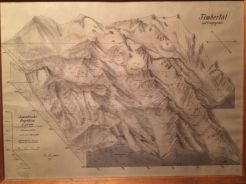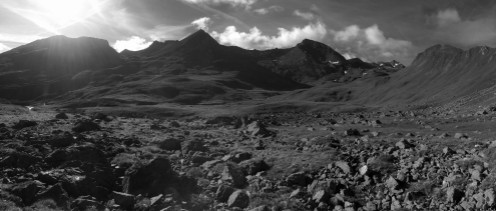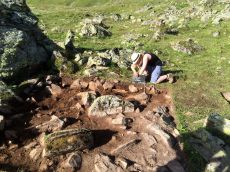The fragmentary nature of many archaeological finds can make our work challenging. The anaerobic conditions of the Neolithic and Bronze Age lake side sites of peri-alpine Europe, however, can provide some very welcome insights into the organic part of prehistoric tool kits. It is no surprise that the almost completely preserved sickle from Solferino inspired French archaeologist André Vayson de Pradenne (1919) to address the still unresolved issues of the use of certain lithic artefacts and the polish that can be seen on them.
This sickle was found some time before Vayson saw it in peat bogs just south of the Lake of Garda. It consisted of a number flint blades that fitted seamlessly next to each other in a groove in a wooden haft. They were glued in with a smooth mastic and protruded ca. 12mm from the haft. The form would suggest use as a knife or saw would be impossible. Vayson commenced on a large comparative study of all known sickle and sickle like artefacts from Europe and the Near East. And although he does not describe them elaborately, he does some experiments, trying to work wood and grasses with sickle like flint tools. He come to the conclusion that the artefacts must have been used as sickles, but also argued that wood as well as grasses can produce polish.

Modern serrated flake with broad band of lustre experimentally produced by cutting straw (x2). From Curwen 1930.
British surgeon and archaeologist E. C. Curwen shows much respect for Vayson’s work, whose 1919 paper he summarises elaborately in English in his article in Antiquity (Curwen, 1930). He is, however, not satisfied with Vayson’s results and does more experiments from which he concludes that working grasses and woods each produces distinctive kinds of polish.
When Dorothy Garrod finds sickle blades set in bone handles with polish from Natufian layers in Palestine, this raises new questions about the timing and process of the start of cereal domestication in the Near East. René Neuville discusses the issue in a 1934 paper, building on Vayson’s work and criticizing part of Curwen’s 1930 conclusions (Neuville, 1934). As a result Curwen decides to do more experiments in order to finally get to the bottom of what causes polishes and to address the domestication questions (Curwen, 1935).
Aiming to reproduce more realistic durations of tool use, Curwen devises a mechanical experiment. He sets a number of experimental artefacts made from two kinds of flint into an electric lathe and as such they were used to `work´ bone, oak wood and compressed straw with (30 minutes each; straw 3500 rotations/minute, bone and wood 2500). The results supported the view that lustre and its development is not just the result of the intensity of use, but also conditioned by the worked material. In the case of these sickles Curwen concluded that the worked material was probably a siliceous plant material of “a yielding nature”. It was thus established that the type of tool, the worked material, the length of use as well as the kind of use all influence the build-up of polish. With this Spurrell, Vayson, Neuville and Curwen had set the parameters for most use wear studies to this date.
It is fascinating to see the photographs Curwen used in both, otherwise relatively sparsely illustrated, 1930 and 1935 publications to illustrate his findings. Although his photos are not microscopic (scale 2:1 and 2½:1), their aesthetics foreshadow those of the microscopic photography of use wear traces on lithic artefacts that have become the norm during the past sixty years or so. The photography used by most presenters at the Usewear2012 conference last September still stuck to these aesthetics, which can be described as a visual vocabulary. Only recently, really with the appearance of digital photography and SEM-technology, do we see a widening of this visual vocabulary within the discipline of use wear analysis.
Lastly, Curwen’s use of mechanic experiments seem to have been rather forwards looking. It has not become the norm in experimental archaeology, neither in use wear analyses, but it might have a future after all. The mechanical experiments allowed Curwen to reproduce intense artefact use with each of the experimental artefacts and enabled him control the parameters of his study and to make direct comparisons between the polish developed on each tool. In a study by Iovita et al (Iovita et al. In Press) mechanised experiments are used to control the experiments parameters and enable reproducibility. Mechanised experiments might also allow for larger reference samples for use wear studies.
Microscopy has not entered the discipline of lithic use wear studies in the 1930’s yet. Researchers had been able to define the factors causing polish and the discipline’s visual repertoire had been established by a small group of researchers working across Europa and the Near East engaged in an international debate, doing experiments and willing to try new methods and to learn from each other.
Literature
CURWEN, E. C. 1930. Prehistoric Flint Sickles Antiquity, 4, 179-188.
CURWEN, E. C. 1935. Agriculture and the Flint Sickle in Palestine. Antiquity, 9, 62-66.
IOVITA, R., SCHÖNEKEß, H., GAUDZINSKI-WINDHEUSER, S. & JÄGER, F. In Press, Projectile impact fractures and launching mechanisms: results of a controlled ballistic experiment using replica Levallois points. Journal of Archaeological Science.
NEUVILLE, R. 1934. Les débuts de l’agriculture et la faucille préhistorique en Palestine, Jerusalem.
VAYSON DE PRADENNE, A. 1919. Faucille préhistorique de Solférino. L’Anthropologie, XXIX, 393-422.
































